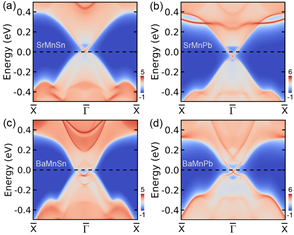Recently, Prof. Dai Ying's group, from School of Physics, predicted the long-awaited antiferromagnetic topological insulators (AFM TIs) in two dimensions, and therefore realizing a novel magnetic TI different from the quantum anomalous Hall effect. Related results have been published in Physical Review Letters 124,066401 (2020) in collaboration withForschungszentrum Jülich, Germany.The first author of the paper is Prof.Niu Chengwang, and the corresponding author is Prof. Dai Ying.

Acting as one of the most active topics in modern condensed-matter physics, topological states in antiferromagnets provides an exciting platform for exploring prominent physical phenomena and applications of AFM spintronics. Protected by the combination of time-reversal symmetry and half-lattice translation,AFM TIs have been obseved expermentally in three dimensions and risen recently to great prominence since they manifest in fascinating phenomena, such as the axion states.However,the realization of such AFM TIs in innately two-dimensional magnetic materials is remarkably elusive although the latter systems are perceived as a key foundation for both present and future information technologies.
While predicting a two-dimensional antiferromagnet is interesting by itself, using a tight-binding model and first-principles calculations, Daiet al.show that in contrast to previously observed AFM TIs in three dimensions, an AFM TI can emerge in two dimensions as a result of a nonsymmorphic symmetry that combines the two-fold rotation symmetry and half-lattice translation. Based on the spin Chern number, Wannier charge centers, and gapless edge states analysis, Daiet al.identify intrinsic AFM SrMnSn, SrMnPb, BaMnSn, and SrMnPb as experimentally feasible examples of predicted topological states with stable crystal structure and giant magnitude of the non-trivial band gaps, reaching as much as 186 meV for SrMnPb, thereby promoting these systems as promising candidates for innovative AFM spintronics applications.
Since 2010, the research of two-dimensional materials and topological states have been carried out by Dai's group. The related works have been published in Physical Review Letters, Nature Communications, Nano Letters, ACS Nano, and Physical Review B with many works are selected as ESI top 1% highly cited papers.
The results are supported by the State Key Laboratory of Crystal Materials, National Natural Science Foundation of China, Shandong Provincial Natural Science Foundation of China, Shandong Provincial Key Research and Development Program (Major Scientific and Technological Innovation Project), Taishan Scholar Program of
Shandong Province, and Qilu Young Scholar Program of Shandong University.
The link of this paper:
https://journals.aps.org/prl/abstract/10.1103/PhysRevLett.124.066401
Source: School of Physics
Written by:Niu Chengwang
Edited by: Che Huiqing